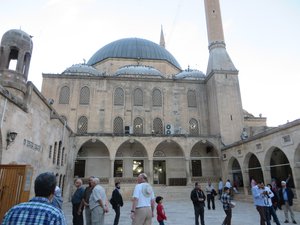Advertisement
Published: October 26th 2014

 Mosque outside Abraham's cave.
Mosque outside Abraham's cave.
Mosque has also been used as a temple & church. We boarded the bus this morning and within 10 minutes, came across a wedding celebration. Our bus driver got off and asked them if we could take pictures -- he spoke for our guide since he is of Kurdish decent, as are the celebrants. Check out the pictures -- there were 3 musicians who beat drums and played for the people as they danced. We joined in and were treated as honored guests. The bride and groom won't arrive until this evening when they will also serve food. The groom's mother came to our bus to give us the customary welcome and someone brought me a scarf to wear (or, wave) during the dancing. I gave a beanie baby to a young child.
We continued on to Harran where Abraham lived 4,000 years ago. We passed by several large mounds of earth which are historic settlements that have yet to be explored. This is by far the most historic country we have visited with ancient ruins everywhere. It is surely an Archaeologists dream to be here. There were also many cotton fields flanking both sides of the road and even though it is a Sunday, there were lots of cotton
pickers out in the fields picking by hand. We didn't see any machinery other than a few tractors. The road was also flanked by pistachio trees.
At one point we took a turn in the road to go east and were told that if we continued south another 6 miles we would reach the Syrian border. At the border, if we were to turn right (west) and go another 6 - 7 miles we would be at the border town of Kobani which is where the bombings are taking place. There are also other areas being bombed right along this same border area. We did not see any indications of unrest except that the tourist trade has dropped to nearly zero which is hurting the economy, of course.
We got to Harran where the city walls surround the city and date back to 3,000 B.C. We then went to an old village outside of the Harran city limits to visit an excavation site which sits up high over the small village. The village houses were all "beehive" which is a design from about 260 years ago and are still lived in today. Several tall beehive structures made of
mud & straw walls keep people cool in their houses as well as provide protection from the elements. They all connect so that each beehive structure passes into the next with short tunnels or simply an open doorway. They resemble cave-like rooms as there are no windows. Each room is used differently -- bedroom, kitchen, living room, work room etc. We sat in the courtyard with the man who owns the home that is open for the public to see. His family lives in a similar home across the street He was very pleasant and sat and talked with us for quite awhile. He has 14 children and one wife. Bob bought a special chili type seed that they eat and attribute health to these mild chilis. They claim that no one has any stomach problems.
Next, we visited the latest big archaeological find which just 2-3 years ago was featured in National Geographic. It is GOBEKLI TEPE and is from 9,000 B.C. the oldest known civilization and temple in the world. This dates back to 1,000 years more than what was thought was the oldest civilization previous to this find. Our guide visited this site soon after it
was first discovered and spoke with the farmer who owns the land and made the discovery. He gave the farmer a copy of the NG article which was the first time the farmer had seen it. Erol took us to the site even though it is not on our normal itinerary because it is such an important find. The farmer was trying to remove rocks from his land and came across a huge rock he couldn't break. After reporting it and finding out what it was, he donated it to a museum which then followed up with the discovery. It is now being explored and we got to walk through the area --- this was by far the most fascinating and interesting discovery on this trip.
Upon our return to Urfa we went near enough to a refugee camp to see it from the road. The normal road we would have taken would go right by several but our driver said it was too dangerous to go that way. With the one we saw from a distance, we saw the Turkish flag flying, high fences surrounding the camp and guard towers at each corner.
After a late lunch
this afternoon, we visited where Abraham was born in a cave. We also went into two mosques, one was right where he was born and the other over by the pond of fishes (refer to yesterday's story about Abraham and Nimrod).
Advertisement
Tot: 0.075s; Tpl: 0.013s; cc: 5; qc: 45; dbt: 0.047s; 1; m:domysql w:travelblog (10.17.0.13); sld: 1;
; mem: 1.1mb











